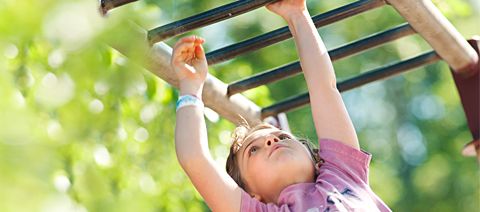The Importance of Child's Play
| August 2013A new study of how preschoolers spend their days may make you want to run around screaming, which is apparently more than the tykes themselves get to do. After interviewing child-care providers from 34 very different Cincinnati-area centers—urban to suburban, Head Start to high income—researchers found that kids spend an average of only 2% to 3% of their day in “vigorous activities.”
Can you imagine that? Children spending 97% of their day not running around? It’s like a desk job, except with cookie time. Excuse me—apple time. When you consider that three-quarters of American kids aged 3 to 5 are in some kind of preschool program and a lot of them come home only to eat, sleep and go back again, this is beyond sad—it’s bad. Bad for their bodies, their brains, their blubber. Baddest of all are the reasons behind this institutionalized atrophy: The quest for ever more safety and education.
Let’s take a look at both these concerns, the twin fears haunting modern-day childhood.
Fear of injury: The centers, the parents and the state regulators are all so worried about injuries that they end up steering kids away from play. They do this in part by only approving playground equipment that is so safe it is completely boring to the kids. As one child-care provider told the investigators, “We used to have this climber where they could climb really high and it was really challenging. Now we have this climber that looks cute, much cuter than the old one, but it’s not as high and . . . scary.”
“Scary” equals “fun” for kids. (It equals potential lawsuit to everyone else.) Faced with this pitiful excuse for a plaything, the kids started doing things like walking up the slide. But of course, that is verboten, too, because a kid could get injured! As several child-care providers told the authors, “the [safety] guidelines had become so strict that they might actually be limiting, rather than promoting, children’s physical activity.”
Uh, “might”?
Fear #2: Falling behind. The trembling triumvirate of child-care providers, parents and regulators also worries that kids must perform at a certain level when they reach school, so play time is sacrificed for academics. Some parents specifically request that their kids not participate in outdoor activities but “read a book instead”—an attitude that spans the economic spectrum.
The funny thing is, if you are really concerned about children’s health and school-readiness, there is a very simple way to increase both. It’s called playing.
Kids learn through play. When kids play, they’re not wasting their time. They’re learning everything from motor skills to social skills and numbers. Kids playing outside also learn things like distance, motion, the changing of the seasons—things we take for granted because we got time outside. But many of today’s kids spend all their daylight hours in child care.
And on the physical side of things, kids outside literally learn how to move. Joe Frost, a professor emeritus at the University of Texas and author of 18 books on child’s play, has been watching for decades as dwindling time outside and increasingly insipid equipment got to the point where many 21st-century kids “are unsafe on any environment, because they have not developed the strength, the flexibility, the motor skills that come with being a well-rounded child.” They don’t even know how to fall safely, which makes them more likely to hurt themselves. So much for making kids safer by limiting their playground time.
As for the biggest health risk of all: 19% of kids are showing up at kindergarten already obese. They’ve started out on a life of couch potato-dom. Some don’t even know how to skip. “We’re seeing what we used to call ‘adult’ diabetes in children as young as 3, 4, 5,” says Dr. Copeland.
In striving to make our kids super safe and super smart we have turned them into bored blobs. Fortunately, the remedy is as simple as it is joyful: Just see the playground the way kids do. Not as an academic wasteland. Not as a lawsuit waiting to happen. Just the very best place to spend a whole lot of time.







